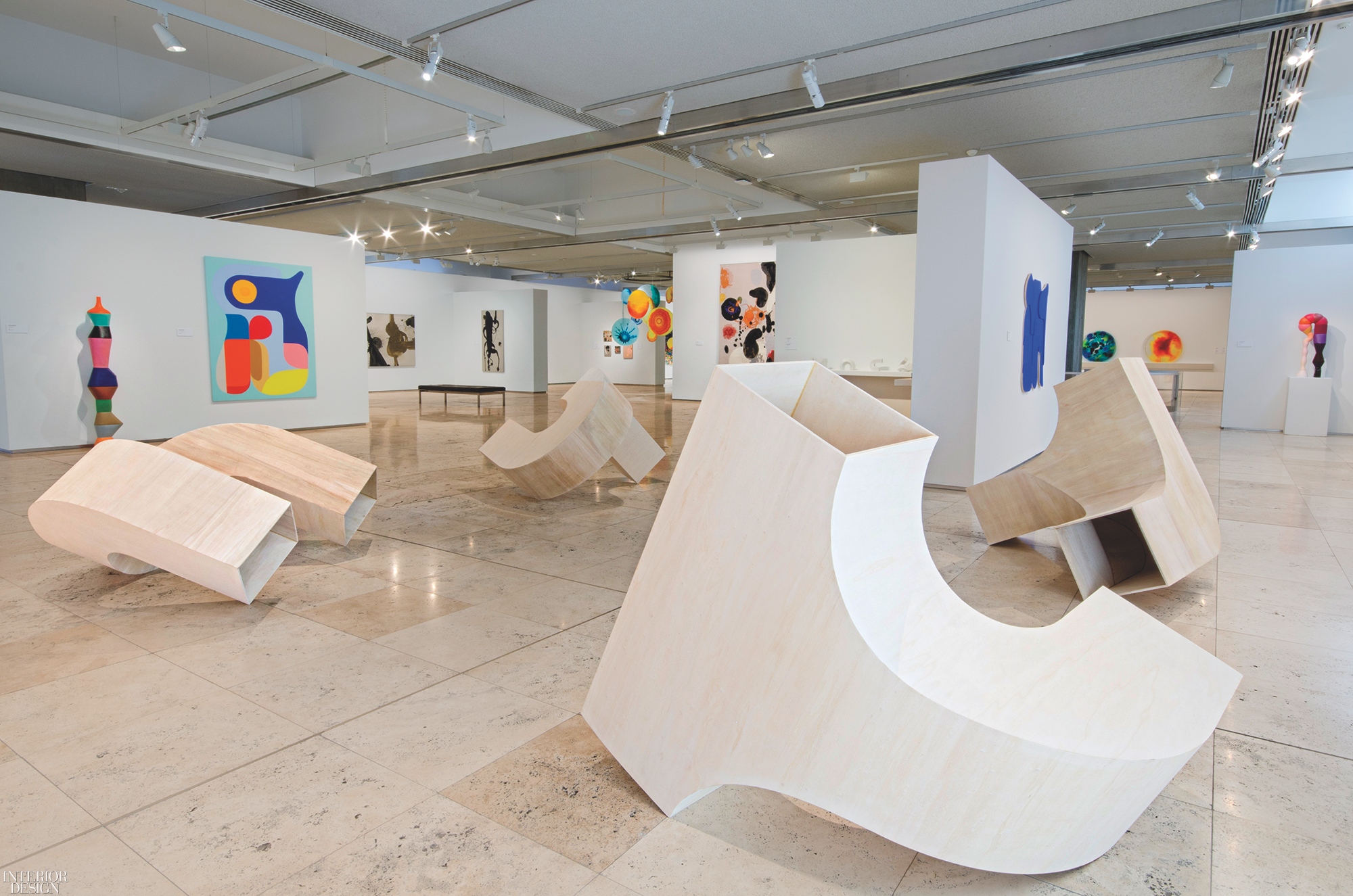Dinosaur Designs Duo Renders Sculptural Accessories in Bold, Full-Spectrum Colors
 About the name. “It was the 1980s,
About the name. “It was the 1980s,
a crazy, absurd time, and we were art students,” says Stephen Ormandy, explaining the quirky moniker Dinosaur Designs. He hatched the business in 1985 with his now wife, Louise Olsen, and Liane Rossler when they were students at Sydney’s City Art Institute. Thirty-odd years later, the jewelry and tabletop company (sans Rossler since 2010) has become a veritable design powerhouse, with eight stores worldwide and
90 employees, including 48 in its Sydney studio, where every resin piece is hand-poured.
The couple’s sculptural accessories—chunky cuffs, pebble-like necklaces, organically shaped plates—are rendered in bold, full-spectrum colors. The marbled, translucent, or pigment-saturated resin sometimes combines with sterling silver,
gold, brass, wood, or stone. “It’s the fun of experimenting,” Ormandy notes. Alongside their studio output, which includes a collaboration with Louis Vuitton, Olsen and Ormandy engage in their own art projects, recently the subject of an exhibition at Newcastle Art Gallery in Australia. Talent will out.
ID: When and how did you meet?
Louise Olsen: On the first day of art school in 1983. Classes were set up alphabetically and both our names began with “O.” Sometimes you meet someone and get that feeling of destiny.
ID: You started out as vendors at Paddington Markets?
Stephen Ormandy: I sold jewelry to pay my way through art school.
LO: I was selling my hand-painted T-shirts to stores.
So, we were both doing our own little creative endeavors.
Dinosaur Designs started to support our art careers.

ID: How did you get into resin?
SO: I’d already been introduced to it as a surfer, fixing my board. But that type of resin is very different than the one used for casting. We “met” resin at the markets. We had been playing around with Fimo polymer clay, hand-painting it and baking it in the oven, when we met Geoffrey Rose, a contemporary artist making little resin sculptures of, say, milk pouring onto corn flakes—the pop art versions of Japanese display food. He encouraged us to try resin, and it went from there.
ID: What draws you to the
material?
SO: Opportunity. Resin continues to show us new things.
LO: Resin’s very fluid. It’s a lot like paint in that you can mix it in any array of colors. We’ve been working with it for over 30 years and still don’t feel we’ve hit its limit.

ID: How do you develop a
collection?
LO: Usually, we start with a title. We develop ideas in a sketchbook and then make prototypes, sculpting mainly in Plasticine. Eventually, we end up with production molds from which items can be cast in multiples.
ID: You’re both practicing artists.
LO: The Newcastle Art Gallery just had an exhibition of our paintings and sculptures.
Stephen’s been painting for quite a few years and I’ve started more recently.
SO: I have upcoming shows in London and at New York’s Olsen Gruin Gallery. Dinosaur really took over for quite some time because of its expansion. We still love it, but we just thought, Oh my god, let’s not forget why we started!

ID: You’ve also branched into sculpture. Stephen, what sparked the totems?
SO: The series grew out of the visual language of shapes I’ve been developing in painting. Having a sculptural practice—which I consider Dinosaur to be—I wanted to bring that to my art, creating shapes that could come together as a 3-D collage, like LEGOs. I’d love to do more large-scale public sculptural work. I’ve done some in China but not yet in Australia.
ID: Do your art projects connect to or differ from your design work?
SO: They talk to one another, don’t they?
LO: Yeah, very much so. It’s all starting to relate. Art is not limited to one medium: Calder made jewelry, Picasso made jewelry and ceramics, Giacometti made housewares and furniture.
SO: We consider Dinosaur more artwork than design, to tell you the truth. We are obsessed with the quality
of things. We apply the same visual rigor to a tiny bead as we do to a large table.

ID: What inspires you?
SO: The natural world.
The color palettes you
find just walking around
are incredible.
LO: And the way nature takes time to develop and evolve is so interesting. Our current collection is inspired by lapis, that beautiful blue, to which we added clay and bone hues. And seaside
living inspired our recent
Rockpool collection.
ID: How do you
approach color?
LO: It’s quite instinctive, like playing a piece of music—except you’re playing with
visual “notes.”

ID: What have been some milestones though the years?
SO: Opening our first New York store, in 2002, on Mott Street. Then we moved to Elizabeth Street and now we’re in a new store on Crosby Street, designed by BKH, which opened two years ago.
LO: We wanted this one to
be more like our Australian stores: lighter and brighter,
a real backdrop for color.
It’s our little gallery in a way.
Another milestone was the 1989 Victoria & Albert Museum exhibition on Australian design that we were included in. From that, we started wholesaling in London at Harvey Nichols, then went to New York and sold through Donna Karan and now Bergdorf Goodman. It builds its own momentum: The more you do, the more you create. The world works like that, doesn’t it?
> Check out more Sydney design talent by reading 10 Questions With… Tom Fereday.


